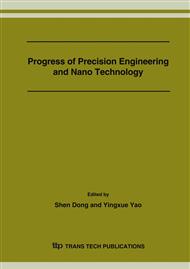p.442
p.447
p.453
p.458
p.463
p.469
p.473
p.479
p.483
Effect of Nanostructured TiH2 on the Formation of Multimeshworked and Nanoporous TiO2 by Cathodic-Anodization Treatment
Abstract:
Cathodic-anodization process was performed to treat titanium sheets to improve biocompatible performance. Grazing incident X-ray diffraction, transmission electron microscopy, scanning electron microscopy and electrochemical measurement were used to evaluate the influence of hydrogen on the formation of nanoporous TiO2. Multimeshworked and nanoporous TiO2 was observed after treatment with cathodic-anodization process. The nanoporous oxide layer is hard to form without nano-TiH2. The nano-TiH2 plays an important role in forming multimeshworked and nanostructured TiO2 layer. Hydrogen charging by cathodization is believed to enhance the formation of nanoporous oxide film and thus promote biocompatibility.
Info:
Periodical:
Pages:
463-468
Citation:
Online since:
May 2007
Authors:
Price:
Сopyright:
© 2007 Trans Tech Publications Ltd. All Rights Reserved
Share:
Citation:


